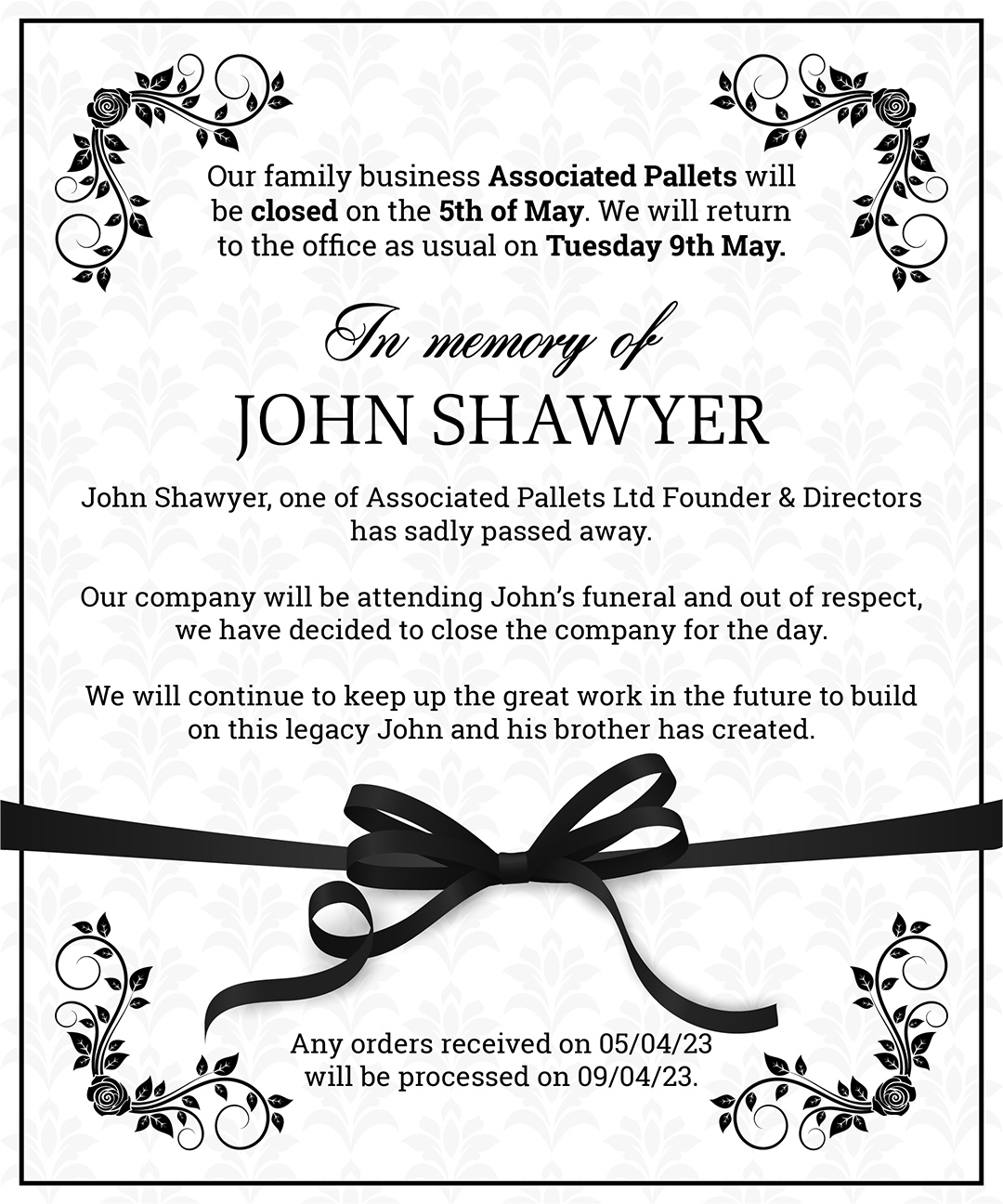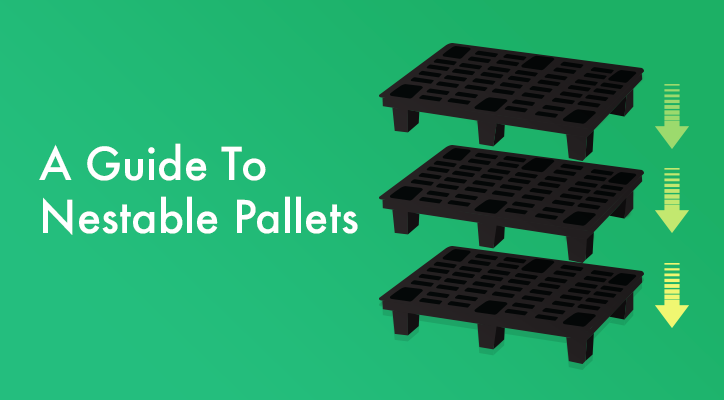A Guide To Nestable Pallets
12 Jun 2019
When most people think of pallets, it tends to be wooden ones that first spring to mind.
With well over 90 per cent of the pallet market still dominated by wood, it is easy for many not even to consider plastic pallets as a viable alternative.
However, over the last decade, plastic pallets have been further developed to offer consumers increased value, higher performance and greater sustainability.
Throughout the same period, there has also been a growing recognition of the global challenges posed by issues such as climate change, limited natural resources, and population growth.
In response, the international community has developed and introduced a range of new laws, policies and goals. The aim of these new measures has been to call on all stakeholders to play their part.
Many companies across the globe are now recognising the need for greater sustainability and the benefits it can bring.
This move towards more environmentally friendly and sustainable business practices has caused growth within the plastic pallet market.
Recent industry reports have identified that demand for plastic pallets is set to grow faster than any other material due to increases in manufacturing and retail across the globe.
Over the next six chapters, we’ll be looking into the unique benefits of one specific type of plastic pallet:
Nestable pallets.
By the end, you should have a pretty good understanding of what they are, how they’re made, and how they can benefit your business.
So without further ado – let’s begin!
CONTENTS
Chapter One: How To Choose The Right Plastic Pallet For Your Business
Chapter Two: What Is A Nestable Pallet
Chapter Three: How Nestable Pallets Are Made
Chapter Four: The Benefits Of Using Nestable Pallets
Chapter Five: Nestable vs Stackable Pallets
Chapter Six: Conclusion
Chapter One – How To Choose The Right Plastic Pallet For Your Business
Before we take a more in depth look at nestable pallets, there are a number of factors that you might first want to consider.
Not all pallets are the same, and neither are the tasks that they are expected to accomplish.
Generally, there are three key factors that will ultimately determine what pallet style you choose.
They are weight, journey type and management.
Journey Type
The destination of your goods is a major factor when selecting the right type of pallet for the job. As you can probably imagine, there is a big difference between shipping goods to a country in Asia and sending them to a suburban address within the EU.
When shipping goods abroad, there are many other parameters to factor in, such as inspections, border controls and regulations to guard against infestations or parasites.
You will also need to consider whether the pallets will be used multiple times or just once.
For pallets that are expected to make multiple journeys, you will want to ensure that you are getting a pallet that is durable and will keep your cargo safe.
Weight
When choosing the right pallet for your business, you will also need to factor in the weight of the goods you are transporting.
Some goods are much heavier than others, so the pallet you choose MUST be strong enough to give adequate support.
Often, pallets are required to be compatible with a range of automated systems in different warehouse and storage facilities. These requirements can also include forklift compatibility and being able to be stacked during storage.
Management
Pallet management, which is often overlooked, is another factor worth considering.
To ensure fast and effective delivery, you will want to be sure that the pallet provider that you select can provide pallets if and when you need them.
A pallet provider who has a quick turnover time can also be handy when there is a large or unexpected demand for additional pallets.
Chapter Two – What Is A Nestable Pallet?
Nestable pallets literally do exactly what they say, nest inside each other.
Their unique design means that when they are empty, they can fit together in a compact way that is easy to store and takes up less space.
They can be used exactly like other types of pallets. Goods are loaded onto a nestable pallet and then shrink wrapped or strapped in place ready for transportation.
Their main function is to provide a more efficient storage solution.
When in storage, they can be piled quite high in tight, neat stacks. This can help businesses decrease freight and storage costs in the long run.
They are excellent at maintaining their structure and are highly resistant to weathering, rot, corrosion and chemicals.
The main reason for any business who is considering buying these versatile pallets is if they require them back on a return journey.
Unique Design Features
There are a number of unique design features that can be found within this style of pallet.
Typically, nestable pallets will have a much bigger contact surface area, which allows them to hold twenty per cent more than standard pallet models. However, they are not ideally suited to heavy load environments due to the way they are produced.
They also tend to be much lighter than other pallets, such as stackable. This means that they can offer businesses a much more efficient way of transporting their goods.
Durable
Despite being light, these pallets are very strong, with some models being capable of holding as much as 2,300kg.
Many models also feature safety rims which can help prevent the cargo from sliding whilst in transit. If requested, skids can be added, which allows exporters to block stack them.
Chapter Three – How Are Nestable Pallets Made?
Unlike wooden pallets, there are many different manufacturing techniques that are used to produce plastic pallets. Each manufacturing process has its own unique set of advantages and disadvantages.
Thermoforming is a plastic moulding manufacturing technique that is used to create a variety of usable products. Nestable pallet concepts were developed using this process.
This technique involves heating thin plastic sheets to a near liquid form so they can be pulled and manipulated into shape. Once at the correct temperature, the pallet is then formed over a male or female mould. The cooled finished product (pallet) is then trimmed in order to increase usability.
Types
There are two main types of thermoforming: vacuum and pressure forming.
Vacuum Forming
Vacuum forming uses both heat and pressure to draw plastic sheets into its final configuration. Once the plastic has reached the correct temperature it is placed over a mold, a vacuum is then used to manipulate it into the desired shape.
Pressure Forming
Similar to vacuum forming, this manufacturing process has the added benefit of additional pressure. This pressure enables the manufacturer greater control over detail and texture.
Advantages
One of the main advantages of this manufacturing technique is that it is very adaptable. Coupled with a fast turnaround time, this technique can be used to create last-minute shipments quickly.
It is also a relatively low-cost means of producing plastic pallets. Nestable pallets can be anywhere between 50 – 80% lower than the cost to produce a stackable pallet. The raw material costs, such as plastic, dictate the range in savings.
Chapter Four – The Benefits Of Using Nestable Pallets
Nestable pallets are one type of pallet that is highly useful in many different industries.
Businesses and manufacturers are always looking for new innovations to make the use of pallets easier and more efficient, and nestable pallets have achieved just that.
If you use nestable pallets in your warehouse or business, you will receive the following benefits:
Saved Space
Arguably, the largest benefit of nestable pallets is the space saving qualities they can bring to businesses.
This means that pallets can be stored in smaller stacks freeing up valuable warehouse space for businesses and manufacturers. This also allows manufacturing plants to store more pallets on site, maximising the space available to store products, equipment, machinery etc.
Cost Benefit
Nestable pallets can help businesses cut freight and storage costs in the mid to long term.
If a business can store pallets between uses, then it can save money by eliminating the need to purchase new pallets each time. They can also maximise their storage space, making the cost per pallet significantly less.
Depending on the raw material cost, nestable pallets can be anywhere from 50-80% cheaper than other types of pallets. They are also very light, which, when coupled with their space saving properties, can significantly reduce shipping costs.
Small financial advantages like this can quickly add up to help make a business more profitable.
Environmental Impact
The materials used in Nestable Pallets make them as reliable as they come, and they can be reused for years without any problems. The ability to store more pallets in a smaller space can have a positive effect on the environment and reduce waste.
Not only do nestable plastic pallets take up less space, but they also give businesses the option to store and reuse them in the future. This reduces the need to purchase new pallets and is a more sustainable way of running a business.
The space saved also allows businesses to use the space and natural resources for other uses.
Improved Hygiene
Compared to more traditional pallet designs, like wood, nestable pallets made from plastic offer enhanced hygiene and sanitation.
Plastic is highly resistant to all forms of contaminants. That’s why nestable pallets are often used in industries such as food processing and pharmaceuticals.
Chapter Five – Nestable or Stackable Pallet?
Most suppliers or manufacturers will categorise pallets into “nestable” and “stackable” categories.
Stackable Pallets
A stackable pallet is a plastic pallet that has a solid platform on its base. This platform may be attached to it in many different configurations, such as a picture frame, runners or a crossbar.
This allows the pallet to be double-stacked on top of one another when empty. Some pallet designs allow for a large pallet to stack above a smaller one and vice versa. The stacking can continue up to a calculated height that ensures the overall load remains level.
The Main Differences
Design
The main difference between these two styles is how they are stored. Nestable pallets are much better at saving space as they can nest underneath one another, allowing more pallets to be stored in the same space. Stackable pallets can only be placed one on top of the other.
Capacity
Another difference between these two types is their load capacity. Stackable pallets are able to carry a much heavier load over a longer period of time when compared to nestable pallets.
Space
The space difference between both these types of pallets is very minimal and shouldn’t affect your options.
Cleaning
Both types of pallets are easily cleanable, but stackable is generally better suited due to it being a little stronger and more durable.
Chapter Six – Conclusion
There you have it.
Everything you’ll ever need to know about the humble nestable pallet.
We’ve taken a look at what your business needs to consider before buying any type of pallet.
How nestable pallets can offer convenient, cost effective ways of storing your pallets whilst offering all the same benefits of traditional styles.
We’ve also looked at how they are produced and the limitations this places on this specific design.
If you have any further questions about this type or any other type of plastic pallets, then please feel free to contact a member of our team for more information.
In the meantime, try checking out our blog.

